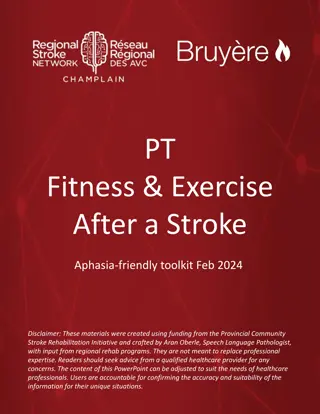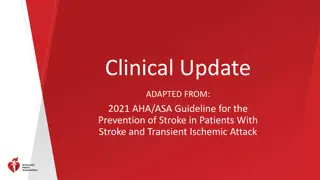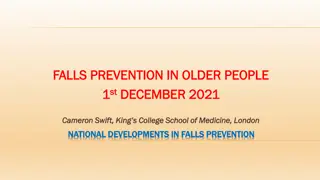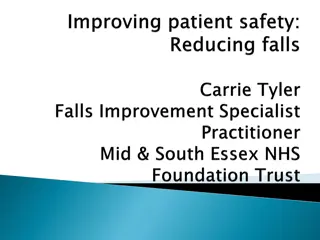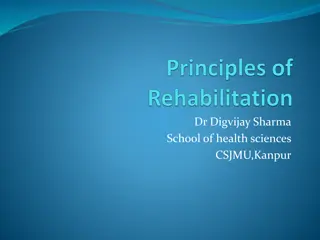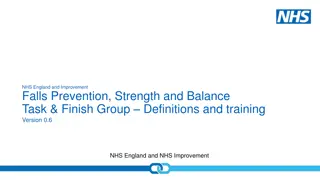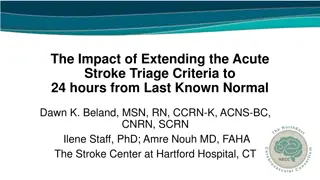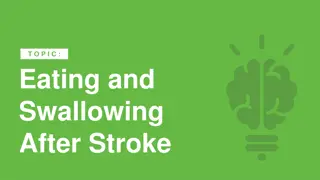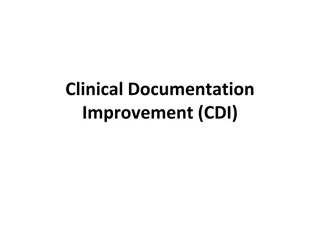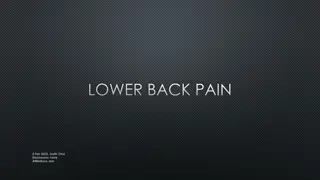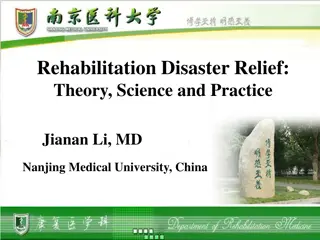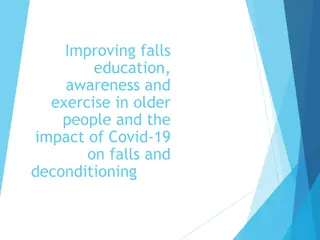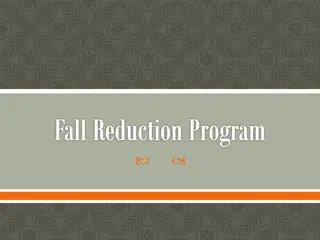Understanding Stroke-Specific Etiologies and Interventions for Falls in Inpatient Rehabilitation
Falls are a common complication after stroke, leading to hip fractures and various secondary complications. Inpatient rehabilitation often focuses on interventions to reduce stroke-related falls, considering factors like muscle tone, cognitive impairments, and balance deficits. Understanding these stroke-specific etiologies and available interventions is crucial to improve patient outcomes and reduce caregiver stress. Various assessments and training parameters, such as balance training tailored to individual needs, play a key role in addressing falls in this population.
Download Presentation

Please find below an Image/Link to download the presentation.
The content on the website is provided AS IS for your information and personal use only. It may not be sold, licensed, or shared on other websites without obtaining consent from the author. Download presentation by click this link. If you encounter any issues during the download, it is possible that the publisher has removed the file from their server.
E N D
Presentation Transcript
Natalie Lawler, SPT UNC-Chapel Hill
The learner will: Understand basic stroke-specific etiologies for falls in individuals in inpatient rehabilitation Have a general overview of available interventions commonly used in the clinic Understand, more in-depth, three common interventions aimed at decreasing stroke-related falls in inpatient rehabilitation. Understand and apply training parameters for balance training and the importance to cater those to each patient.
Falls are the most common complication after stroke (Schmid et al 2010) 27% of persons with stroke will sustain a hip fracture on the paretic side; consequential fear of falling less mobility secondary complications (Weerdesteyan et al 2008) Caretaker stress and patient anxiety and depression after a fall (Weerdesteyan et al 2008)
Reduced muscle tone, paralysis and hypoesthesia on involved side (Tsur, Segal 2010) Lower functional status, history of anxiety, lower NIHSS scores (Schmid et al 2010) Limited social support, nonuse of walking aid, minimal grip strength on affected side (Baetens et al 2011) Lower FIM scores at admission (Forrest et al 2012) Inability to integrate somatosensory, visual and vestibular information adequately (Bonan et al 2004)
In IP rehab, most common cause of falls were patients acting against recommendations due to cognitive impairments (Weerdysteyan 2008) In community dwelling persons, those who walked <4,000 steps daily were more likely to have a fall (Weerdesteyan 2008) Decreased performance on balance and functional assessment tests (Simpson 2011) Reduced between-limb synchronization of COP during quiet stance due to motor limb impairment (Mansfield 2012)
For ADLS: quiet stance despite internal (reaching, weight shifting) and external perturbations Ambulation: coordinated muscle movement for forward progression, adequate foot clearance, and stability of the stance limb Complex ambulation: avoid obstacles using cognitive judgment and dual-task ability
Static and Dynamic balance training Ankle-Foot Orthoses Neurodevelopmental Treatment Functional Electrical Stimulation with Gait Training Body-weight Supported Treadmill Training Vitamin Supplements Upper extremity training Biofeedback Training
Definition: training to help maintain postural support in quiet stance with adequate weight shifting ability and postural reactions
Definition: Training to maintain an adequate base of support and upright position despite external perturbations; postural reaction training
(Marigold et al 2005) RCT Tested effectiveness of agility program compared to control to improve balance, postural reflexes, and decrease falls Agility program showed significant improvements in BBS, TUG, Simple Reaction Time, and had decreased falls at follow-up
(Cheng et al 2001) RCT Tested effectiveness of symmetrical body-weight distribution training as compared to a control Duration, symmetrical weight shift, and decrease in falls at follow-up (6-months) were significantly different in the training group
(Tsaklis et al 2012) Pilot study to determine the effects of weight-shift training with visual feedback on improving functional balance and postural support Convenience sample pre and post-test no control group Significant improvements in quiet stance, forward reaching tasks, BBS scores
Defintion: a device used to align the foot and ankle properly, manage plantar flexion tone or provide dorsiflexion assistance
Effects of [custom made thermoplastic]AFO on center of mass in 5 subjects Gait analysis: noted a more vertical displacement of COM More efficient gait pattern with use of AFO, especially during stance phase Requires larger RCT study to make definitive conclusions
Collected RCTs that focused on parameters of balance, gait and mobility Found the immediate effects of AFOs to improve balance, gait and mobility Limitations: no long-term effects determined
Looked at length of footplate to determine ideal kinematics Compared use of: no AFO articulated AFO with 90 deg PF stop & full length foot plate (conventionally aligned) Articulated AFO with 90 deg PF stop & aligned tibia vertical, shoe heel height compensated AFO Articulated AFO with tibia vertical, length foot-plate, and length AFO
Measured sagittal plane kinematics at ankle and knee Results favored articulating AFO with PF stop, with full length foot plate to optimize knee kinematics in early stance (prevent hyperextension)
Definition: Utilization of the upper extremity to aid in balance control during static and dynamic activity
(Waller et al 2012) Case Series Explored effectiveness of training with bilateral upper extremities in improving balance control Training consisted of 5 tasks for 1 hour sessions 3x/week for 6 weeks: 1. grasp, forward reach and release ball in bucket 2. grasp, reach forward through hoop and release ball in bucket 3. grasp with pronated forearm and supinate to place hoop ball on horizontal pole 4.grasp with palmar grasp, flex and abduct arm to place hoop ball on horizontal pole 5. grasp peg ball with supinated wrist, reach forward and place peg in elevated peg board
(Waller et al 2012) Case Series Scores for Sensory Organization Test, BBS, ABC Scale, and directional control of rhythmic weight shift improved from baseline to post-training testing.
Impact of light touch as a balance aid
Largest improvements in lower extremity motor function are achieved in the first three months after stroke Task-specific training to increase skill acquisition and retention Amount of Practice: large amounts of practice are encouraged for skill refinement (i.e. Gait training encourages 1,000-2,000 steps per session) Intensity: Higher intensity preferred to gain aerobic benefits and neuromuscular demand. Also tied to neural excitability for better walking
Tsur A, Segal Z. Falls in stroke patients: risk factors and risk management. Isr Med Assoc J. 2010 Apr;12(4):216-9. Schmid AA, Wells CK, Concato J, Dallas MI, Lo AC, Nadeau SE, Williams LS, Peixoto AJ, Gorman M, Boice JL, Struve F, McClain V, Bravata DM. Prevalence, predictors, and outcomes of poststroke falls in acute hospital setting. J Rehabil Res Dev. 2010;47(6):553-62. WeerdesteynV, de Niet M, van Duijnhoven HJ, Geurts AC. Falls in individuals with stroke. J Rehabil Res Dev. 2008;45(8):1195-213. Review. Baetens T, De Kegel A, Calders P, Vanderstraeten G, Cambier D. Prediction of falling among stroke patients in rehabilitation. J Rehabil Med. 2011 Oct;43(10):876-83. Bonan IV, Colle FM, Guichard JP, Vicaut E, Eisenfisz M, Tran Ba Huy P, Yelnik AP. Reliance on visual information after stroke. Part I: Balance on dynamic posturography. Arch Phys Med Rehabil. 2004 Feb;85(2):268-73. Forrest G, Huss S, Patel V, Jeffries J, Myers D, Barber C, Kosier M. Falls on an inpatient rehabilitation unit: risk assessment and prevention. Rehabil Nurs. 2012 Mar-Apr;37(2):56-61. Simpson LA, Miller WC, Eng JJ. Effect of stroke on fall rate, location and predictors: a prospective comparison of older adults with and without stroke. PLoS One. 2011 Apr 29;6(4):e19431. doi: 10.1371/journal.pone.0019431.
Mansfield A, Mochizuki G, Inness EL, McIlroyWE. Clinical correlates of between-limb synchronization of standing balance control and falls during inpatient stroke rehabilitation. Neurorehabil Neural Repair. 2012 Jul-Aug;26(6):627-35. Marigold DS, Eng JJ, Dawson AS, Inglis JT, Harris JE, Gylfad ttir S. Exercise leads to faster postural reflexes, improved balance and mobility, and fewer falls in older persons with chronic stroke. J Am Geriatr Soc. 2005 Mar;53(3):416-23. Cheng PT, Wu SH, Liaw MY, Wong AM, Tang FT. Symmetrical body-weight distribution training in stroke patients and its effect on fall prevention. Arch Phys Med Rehabil. 2001 Dec;82(12):1650-4. Tsaklis PV, GrootenWJ, Franz n E. Effects of weight-shift training on balance control and weight distribution in chronic stroke: a pilot study. Top Stroke Rehabil. 2012 Jan-Feb;19(1):23-31. Kobayashi T, Leung AK, AkazawaY, Hutchins SW. Effect of ankle-foot orthoses on the sagittal plane displacement of the center of mass in patients with stroke hemiplegia: a pilot study. Top Stroke Rehabil. 2012 Jul-Aug;19(4):338-44. Tyson SF, Kent RM. Effects of an Ankle-Foot Orthosis on Balance and Walking After Stroke: A Systematic Review and Pooled Meta-Analysis. Arch Phys Med Rehabil. 2013 Feb 12. doi:pii: S0003-9993(13)00118- 4. 10.1016/j.apmr.2012.12.025. Fatone S, Gard SA, Malas BS. Effect of ankle-foot orthosis alignment and foot-plate length on the gait of adults with poststroke hemiplegia. Arch Phys Med Rehabil. 2009 May;90(5):810-8. doi: 10.1016/j.apmr.2008.11.012 Jeka JJ. Light touch contact as a balance aid. Phys Ther. 1997 May;77(5):476-87. Hornby TG, Straube DS, Kinnaird CR, Holleran CL, Echauz AJ, Rodriguez KS, Wagner EJ, Narducci EA. Importance of specificity, amount, and intensity of locomotor training to improve ambulatory function in patients poststroke. Top Stroke Rehabil. 2011 Jul-Aug;18(4):293-307. McCombeWaller S, Prettyman MG. Arm training in standing also improves postural control in participants with chronic stroke. Gait Posture. 2012 Jul;36(3):419-24. doi: 10.1016/j.gaitpost.2012.03.025. Epub 2012 Apr 21.



